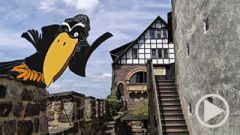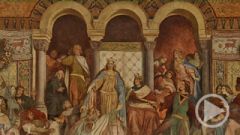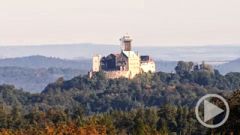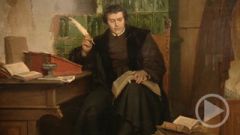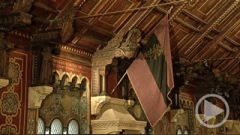Luther auf der Wartburg
The Knights of the Wartburg - A story told by the raven known as Hörsel Crow
Crow! Crow! Over here! What are you staring at? Never seen a knights’ raven before? I live here. I’ve been here for a thousand years. I’m the Hörsel Crow. How about you? Here to find out how a knights’ castle works, eh? Well, I can certainly tell you some stories. Oh, yes, indeedy. I was here, way back when.

The Wartburg is a genuine knights’ castle! Part of it was built long after the knights were gone. But it looks just the way a medieval castle would have done.
It all began with him here. Ludwig. That’s his memorial slab. He was a real knight, complete with a suit of armour, like this one here. Hundreds of years ago, he was riding on his horse through the valley and saw this perfect mountain. So he just had to build a castle on it! Well, he didn’t build it himself, of course. A bunch of builders did the actual work.

It was an enormous task, like a huge construction site in the middle of the forest. Back then, everything had to be done by hand. For instance, this is a construction crane. They did have cranes back then, just not ones that ran on electricity. So lots of men used ropes to haul the heavy stones up. One, two, three, HEAVE! Haha. They used to bore holes into the biggest stones so they could use gigantic tongs to attach them to the ropes. Then, up on the scaffolding, the masons used the stones to build the walls higher and higher.
But the stonemasons weren’t the most important tradesmen at the construction site. No - those were the blacksmiths! Here the fire burned day and night. The apprentice smithy had to keep fanning the flames with a bellows to make sure it got good and hot. The poor lad sweated in the heat. But it had to be very hot, because the hearth was where the iron was heated. When it was red hot, it was placed on the anvil, where the master blacksmith would use a heavy hammer to forge tools for the other building workers. That’s what made him so important. Without chisels, the stonemasons couldn’t hew their stones and without saws, the carpenters couldn’t cut their beams.
They needed those beams for the scaffolding to build the walls. And when the stonemasons were finished, the carpenters built battlements or sometimes whole houses atop the walls. In those days, only the fortress walls, the towers and the main building were made of stone. Wood was perfectly sufficient for all the other buildings. And who made the nails for the beams? Why, the blacksmith! Pretty cool guy.
By the way, the first thing the men built was not a wall or a tower. The first thing they did was put up a wooden shelter for themselves in case it rained. They called it a builders’ hut and, even today, they still exist. Big, old churches call their stonemasonry workshops the “cathedral builders’ lodge”.
So what different parts actually made up a walled fortress like this? And why did Ludwig build it in the middle of a forest on top of this steep mountain? Well, the first reason is that it’s a lot easier to defend against your enemies if you are sitting up above them and they have to come at you from below.
Back then, the knights fought each other with swords and lances to see who was more powerful. Like you see here – these are very old pictures, done during the Middle Ages. If a knight lost a battle, he could always flee back to the castle. That’s why the first thing they needed up on the mountain were high, strong walls.

On top of the walls, they built battlements so that they could use bows and arrows to shoot down from the walls without being hit themselves.
The fortress also had a massive gate at the entrance, with a deep moat in front of it that could only be crossed on the drawbridge. When the drawbridge was pulled up, nobody could get in. Then, if an enemy wanted to conquer the castle, they had to lay siege to it, which means surrounding it with lots of warriors so nobody could get out. They would keep the castle besieged until the people inside defending it ran out of food and had to surrender.
To make sure that didn’t happen, the fortresses were built like little towns, so the people inside could take care of themselves for many weeks. For instance, in the middle of the Wartburg, there is a garden. The knights would have taken walks there from time to time, or met up with their ladies. But mainly it was a place to plant vegetables and herbs, including some that were used in medicines when somebody at the castle got sick.

Everything else people needed to survive was also here. Around the first courtyard are a lot of utility buildings. This is the second section of the fortress. It was known as the outer ward or bailey. Many tradespeople lived here – the groomsmen and farriers, maids and washerwomen, soldiers, and also the reeve. He was the head of the castle when the lord was not in residence. So it was a very lively place. Pigs and chickens were also always kept on the castle grounds – as reserves of meat, on the hoof, as it were.
But when there really was a long siege, food wasn’t even the biggest problem. And thicker walls or sharper swords couldn’t help either. Because the most important thing was enough water to drink! And here the Wartburg had a problem. There’s a spring at the foot of the mountain. That’s where the castle’s residents would get their water. Lots of children ride a donkey up the mountain these days and there were donkeys back then too. They carried all that water up the hill. But during a siege, of course, they couldn’t get into the fortress!
There was no water inside the walls. The little well in the courtyard was built much later. And the large well here isn’t really a well; it’s just a cistern – a tank for storing water. When it rained, they collected the water from the roofs in the cistern. So the castle’s residents could only survive a siege if the weather was perfect. And by that, I mean if it kept raining and raining and raining... Hehehe!
Thankfully, nobody ever really besieged the Wartburg. It served less as a fortress defence than as a castle in which to live. A grandson of Ludwig’s built an enormous residence here. It is the largest and most important building inside the walls. This was really the castle proper.
The living quarters were on the ground floor. The men slept here, in what’s called the knights’ hall. All of them, together! They did not have a lot of furniture, by the way. There were carpets and pillows on the floor, and stools and benches to sit on. But there were no wardrobes. Instead they had chests, such as this one. And there was a fireplace, and even a heating system under the floor! In most castles, it was really freezing in the winter... brrrr.
On the other side was the hall where the women slept. And they all most probably met here in the middle for meals. It doesn’t look now quite the way it did back then. Having a table in the middle of the room is actually historically incorrect. In the Middle Ages, the table wouldn’t have been brought in to the hall until the food was ready. And it was much bigger than this one. Because it wasn’t just the landgrave and his wife who ate here, but a whole lot of other folk too – the knights and their squires, the ladies-in-waiting and chambermaids, the reeve, perhaps visiting knights. Well, the whole court household, really. When everyone was finished with the meal, servants picked up the table complete with everything on it and simply carried it out again. So you didn’t get up from table, it got up from you!

By the way, you might be wondering what they did back then when they needed to ... well, you know. Well, there were toilets in the castle – of course there were! There was a little closet here next to the dining room. It stuck out over the walls. From below it would have looked much like this bay. Inside the closet there was a wooden plank with a hole in the middle that you sat on. And the whole thing was open at the bottom. So best not to be standing just under it! Hehehe.
In the evening, the knights might have played a game. Chess, for instance, had already been invented. Or perhaps they played music and had parties. But the music wasn’t just for dancing. You see, back then very few people could read. So the singers told stories with their songs – almost like a film you could listen to. The singers were big celebrities and some of them were also knights! One of the most famous singing contests of the entire Middle Ages was held here at the Wartburg. Most probably right here in this room, which is why it’s called the “singers’ hall”.
The Great Hall was actually the most important room in the castle. There are even two of them in the Wartburg. Because it was so important, the second Ludwig had an additional hall built on top of the first one. This was not only where he celebrated parties. Most importantly, it was where he held court. He sat on the throne and made decisions or received important guests. For he was a landgrave, one of the most important men in the empire, second only to the king.

But not everyone lived so comfortably. As you might imagine, just like any good castle, the Wartburg also had a dungeon. It is here in the South Tower. The entrance is halfway up the tower, which makes it easier to defend. And below it is a dark room. They would use a rope to lower prisoners through the tiny trap door into the gloomy dungeon. That’s why it was called “the hole of horror”.
I remember very well a man who was later locked up here. Fritz Erbe. He didn’t actually commit any crime. He just thought that people should have the right to decide things for themselves. That got him into trouble with the rulers. But he stuck (firmly) to his beliefs. So he ended up down there, almost 500 years ago. That’s how unjust the human world can be! Good thing you’re not like that today. Or are you? You’re not still unjust, are you?
Speaking of the South Tower, we haven’t actually discussed the towers yet. And a fortress like this isn’t complete without its towers! Just like the whole place, the towers served two functions. First off, you could look down out of their heights and see enemies coming from far away. And then, when the enemies got here, you could shoot down at them with bows and arrows. On the other hand, the towers could also be seen from far off. So the knights used them for boasting rights ... as if the knight with the highest tower was the most powerful of all.
The biggest and highest tower in the fortress, by the way, is called the “keep”. It was the best fortified. If somehow the castle were captured, then the residents could barricade themselves inside the keep as a last resort. And from the top you can see out for many kilometres across the countryside around the castle and enjoy the feeling of being the boss. So. That’s how a fortified castle works. Now you know. And now it’s up to you to become the boss yourself. But not here – no chance! I’m the boss here! TeeHee. And now I’m off. If you’re in the neighbourhood again, do stop by and visit me. So long for now and don’t forget ... I’m the Hörsel Crow!


